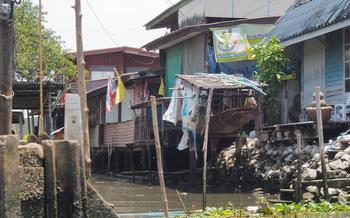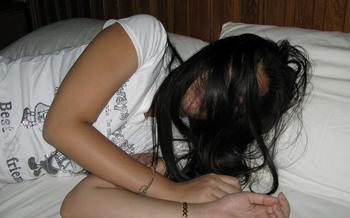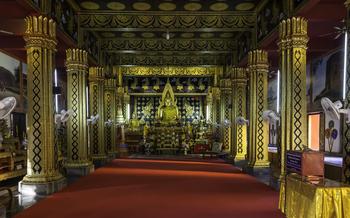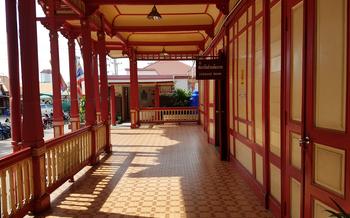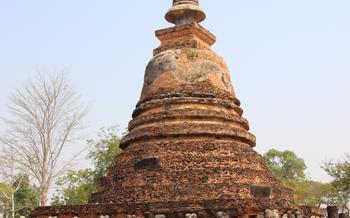
Luang Pho Parn Temple
- A Temple of Historical Significance
- The Revered Luang Pho Parn
- Exploring the Temple Grounds
- Paying Respects to Luang Pho Parn
- The Sacred Buddha Images
- The Importance of Amulets and Relics
- The Local Community
- Festivals and Celebrations
- Exploring the Surrounding Area
- Respecting Temple Etiquette
- Supporting Temple Projects
- Photography and Social Media
- Local Cuisine and Restaurants
- Insider Tip: Discover the Hidden Cave of Luang Pho Parn
A Temple of Historical Significance
Nestled amidst the bustling city of Nakhon Ratchasima, the Luang Pho Parn Temple stands as a testament to Thailand's rich history and cultural heritage. Its origins can be traced back to the Ayutthaya period, when it was established as a small hermitage by a group of Buddhist monks seeking spiritual enlightenment. Over the centuries, the temple has undergone several renovations and expansions, reflecting the changing political and religious landscape of the region.
The architectural style of the Luang Pho Parn Temple is a harmonious blend of traditional Thai and modern elements. The main prayer hall, known as the ubosot, is a stunning example of Thai craftsmanship, with its intricate carvings, colorful murals, and towering spires. Inside, the ubosot houses a sacred Buddha image known as Luang Pho Parn, which is believed to have been created over 300 years ago.
As a place of worship, meditation, and spiritual enlightenment, the Luang Pho Parn Temple holds a significant place in the hearts of Buddhist devotees. Daily rituals, ceremonies, and festivals are held at the temple, attracting both local residents and visitors from around the world. These events offer a glimpse into the vibrant religious traditions and practices of Thailand, allowing visitors to experience the spiritual essence of this sacred place.
The Revered Luang Pho Parn
Luang Pho Parn, born in 1875, stands as a towering figure in the annals of Thai Buddhism. His journey began in humble beginnings, but his unwavering dedication to the teachings of the Buddha propelled him to spiritual enlightenment. He spent decades immersed in meditation and study, mastering the intricacies of Buddhist scriptures and practices. His wisdom and compassion attracted disciples from all walks of life, who flocked to him for guidance and teachings.
Luang Pho Parn's teachings emphasized the importance of morality, mindfulness, and meditation. He believed that through diligent practice, individuals could overcome their afflictions and attain inner peace and happiness. His teachings resonated with people from all backgrounds, inspiring them to lead more virtuous and fulfilling lives.
Miracles and legends surround Luang Pho Parn, further solidifying his reputation as a holy figure. Devotees recount stories of his ability to heal the sick, predict the future, and perform extraordinary feats. These miraculous events, attributed to his spiritual power and compassion, endeared him to his followers and spread his fame throughout the land.
Exploring the Temple Grounds
As you step through the temple gates, you'll be greeted by a serene and tranquil atmosphere that invites you to leave the outside world behind. The temple complex is laid out in a traditional Thai style, featuring a main prayer hall, a sala (a covered pavilion), a chedi (a stupa-like structure), and a viharn (a hall for meditation and ceremonies).
The main prayer hall is the heart of the temple, where devotees come to pay their respects to Luang Pho Parn and seek blessings. The interior is adorned with intricate carvings, colorful murals, and golden Buddha images that exude an aura of spirituality. The main Buddha image, known as Phra Phuttha Chinnarat, is a highly revered image believed to date back to the 15th century.
Surrounding the main prayer hall are several other structures that serve different purposes. The sala provides a shaded area for visitors to rest and meditate, while the chedi is a symbol of the Buddha's relics and teachings. The viharn is used for various ceremonies and rituals, such as chanting, meditation sessions, and ordination ceremonies.
As you explore the temple grounds, you'll notice the beautiful gardens that add to the serene atmosphere. The gardens are meticulously maintained and feature a variety of colorful flowers, shrubs, and trees. There are also several ponds and fountains that create a sense of tranquility and peace.
Throughout the temple complex, you'll find various statues and sculptures that depict important figures from Buddhist mythology and history. These statues are not only visually appealing but also serve as reminders of the teachings and principles of Buddhism.
Paying Respects to Luang Pho Parn
When visiting the Luang Pho Parn Temple, it is customary to pay respects to the revered monk and seek his blessings. As you enter the temple grounds, maintain a respectful demeanor and remove your shoes before stepping onto the elevated platform where the Buddha images are enshrined.
Approach the main altar with reverence and offer a wai, a traditional Thai greeting, to show your respect. You may also light incense sticks and place them in the designated urn as an offering. If you wish to make a donation, there will be a donation box near the altar where you can contribute to the temple's upkeep and support its ongoing projects.
As you stand before the image of Luang Pho Parn, take a moment to reflect on his teachings and the spiritual significance of the temple. You may choose to recite a prayer or mantra, or simply sit in quiet contemplation, absorbing the peaceful atmosphere.
After paying your respects, you may explore the rest of the temple complex, visit the meditation hall, or join the monks for a guided meditation session. Remember to maintain a respectful and mindful attitude throughout your visit, and refrain from loud conversations or disruptive behavior.
The Sacred Buddha Images
Within the hallowed halls of Luang Pho Parn Temple, an array of sacred Buddha images emanates an aura of serenity and reverence. Each statue, meticulously crafted with intricate details, embodies a unique posture, mudra, and symbolic meaning. Visitors are drawn to the serene countenances and graceful forms of these sacred representations of the Buddha.
One of the most striking images is the majestic Phra Sihing Buddha, a replica of the revered original enshrined in Chiang Mai. This awe-inspiring statue exudes an ethereal presence, radiating compassion and wisdom. Its intricate ornamentation and serene expression capture the essence of Buddhahood, inviting visitors to pause and reflect on the teachings of the enlightened one.
Another notable image is the Phra Sangkajai Buddha, renowned for its ability to bestow blessings and good fortune. Devotees flock to this benevolent figure, seeking solace and guidance in their lives. The Buddha's serene smile and gentle posture exude an aura of tranquility, inviting visitors to seek inner peace and harmony.
The Phra Phrom Buddha, representing the Hindu deity Brahma, stands tall with four faces, each gazing compassionately in a different direction. This multifaceted image symbolizes the Buddha's omniscience and his ability to witness all things in the universe. Devotees often make offerings and seek blessings from this powerful representation of the divine.
These sacred Buddha images are not mere objects of worship but embodiments of the Buddha's teachings and principles. They serve as a constant reminder of the path to enlightenment, inspiring visitors to cultivate compassion, wisdom, and inner peace within themselves.
The Importance of Amulets and Relics
In Thai culture and Buddhism, amulets and relics hold significant value. Particularly those associated with Luang Pho Parn are highly revered. These sacred objects are believed to possess protective powers and bring good fortune to their wearers. The process of creating and blessing amulets is intricate, involving rituals and prayers performed by monks. Each amulet is unique, often featuring the image of Luang Pho Parn or Buddhist symbols. Devotees believe that possessing an amulet blessed by Luang Pho Parn brings them safety, good luck, and protection from harm. Amulets have become an integral part of Thai society, not only for religious reasons but also as symbols of faith and cultural identity. Stories abound of individuals whose lives have been touched or even transformed by the power of these sacred objects.
The Local Community
The local community surrounding the Luang Pho Parn Temple is a vibrant and welcoming one, with a rich cultural heritage deeply intertwined with the temple's existence. The temple serves as the spiritual and social center of the community, providing guidance, support, and a sense of belonging to its members. In return, the community offers unwavering support to the temple, participating in its festivals, ceremonies, and maintenance.
The relationship between the temple and the community is symbiotic, with each benefiting from the other's presence. The monks provide spiritual guidance, blessings, and education to the community members, who in turn offer their labor, resources, and devotion to the upkeep and beautification of the temple. This harmonious relationship has been nurtured for generations, creating a strong bond between the temple and its surrounding community.
Visitors to the Luang Pho Parn Temple will have the opportunity to witness this unique relationship firsthand. They may encounter local residents engaged in temple activities, such as cleaning the grounds, preparing offerings, or participating in ceremonies. By interacting with the local community, visitors can gain insights into the daily life and customs of the Thai people and experience the warmth and hospitality that characterize Thai culture.
Festivals and Celebrations
The Luang Pho Parn Temple comes alive during its annual festivals and celebrations, which draw devotees and visitors from far and wide. The most significant festival is the temple fair, held each year in February or March. The temple grounds transform into a vibrant marketplace, with stalls selling traditional Thai food, handicrafts, and souvenirs. Visitors can enjoy colorful processions, traditional performances, and the lively atmosphere as the community celebrates the temple's history and heritage. Other important festivals include Visakha Bucha, which commemorates the birth, enlightenment, and passing of Buddha, and Kathina, a festival where new robes are offered to monks. These celebrations provide a unique opportunity to immerse oneself in Thai culture and witness the deep devotion of the local community.
Exploring the Surrounding Area
After immersing yourself in the spiritual essence of the Luang Pho Parn Temple, take some time to explore the captivating surroundings that beckon with natural wonders and cultural experiences. Just a short distance away, the Khao Yai National Park awaits with its breathtaking landscapes, diverse wildlife, and cascading waterfalls. Embark on a thrilling jungle trek, marvel at the majestic elephants roaming free, and immerse yourself in the tranquility of nature's embrace.
For a taste of local life, venture into the bustling Pak Chong Night Market, where vibrant stalls overflow with an array of delectable street food, handmade crafts, and souvenirs. Indulge in the tantalizing aromas of grilled meats, sample exotic fruits, and haggle for unique treasures that reflect the essence of Thailand's vibrant culture.
Enrich your journey with a visit to the Jim Thompson Farm, a renowned silk producer that showcases the artistry and craftsmanship of Thai silk. Stroll through mulberry fields, witness the intricate process of silk production, and admire the exquisite collection of silk garments and accessories. The farm's serene gardens and charming cafe offer a tranquil oasis to relax and savor the beauty of nature.
Respecting Temple Etiquette
When visiting the Luang Pho Parn Temple, it is essential to observe proper etiquette and customs to show respect for the sacredness of the site. Visitors should dress modestly, covering their shoulders and knees. Shoes should be removed before entering the temple grounds, and it is customary to walk barefoot or in socks. Upon entering the temple, visitors should pay their respects by bowing or wai-ing to the Buddha images and monks. It is considered inappropriate to point at or touch the Buddha images or monks. Silence and mindfulness should be maintained throughout the temple grounds, avoiding loud conversations or disruptive behavior. Visitors should also refrain from smoking, eating, or drinking inside the temple. By following these guidelines, visitors can demonstrate their respect for the temple and its traditions, creating a harmonious and peaceful atmosphere for all.
Supporting Temple Projects
Visitors to the Luang Pho Parn Temple have the opportunity to make a meaningful contribution to its ongoing projects and initiatives. Donations, volunteer work, and fundraising efforts play a vital role in maintaining and preserving this sacred site.
By supporting temple projects, visitors can contribute to the well-being of the monks who reside there, providing them with essential resources and support. Additionally, donations help fund education and healthcare programs for the local community, ensuring that the temple continues to be a source of support and guidance for those in need.
Supporting temple projects is also a way to promote Buddhist teachings and preserve the temple's cultural heritage. Visitors can participate in fundraising events, make direct donations, or offer their time and skills as volunteers. Every contribution, no matter how small, makes a difference in ensuring the temple's continued existence and its ability to serve the community.
One inspiring example of a successful temple project is the construction of a new meditation hall. Through the generous donations of visitors and the hard work of volunteers, the temple was able to build a spacious and serene space for meditation and spiritual retreats. This new facility has provided countless visitors with the opportunity to deepen their practice and find inner peace.
By supporting the Luang Pho Parn Temple, visitors can become part of its rich history and legacy. Their contributions will help ensure that this sacred site continues to thrive and serve as a beacon of spirituality and enlightenment for generations to come.
Photography and Social Media
When visiting the Luang Pho Parn Temple, it is important to be mindful of photography and social media etiquette. While capturing the beauty and spirituality of the temple is encouraged, it is crucial to respect the privacy of others and avoid disruptive behavior. Visitors should refrain from using flash photography or taking pictures of monks or other visitors without their permission. It is also important to be mindful of the sacred nature of the temple and avoid taking inappropriate or disrespectful photos. When sharing photos on social media, visitors should be mindful of the temple's reputation and avoid posting images or captions that could be offensive or disrespectful. Instead, they should focus on sharing the beauty and serenity of the temple in a way that is respectful and inspiring to others.
Local Cuisine and Restaurants
After exploring the spiritual and cultural wonders of Luang Pho Parn Temple, indulge your taste buds with the tantalizing flavors of local Thai cuisine. Venture into the nearby streets and discover a myriad of restaurants and eateries that offer authentic Thai dishes, each bursting with unique flavors and aromas.
For a truly local experience, try the renowned Tom Yum Goong, a spicy and sour soup with succulent shrimp, mushrooms, and lemongrass. Pad Thai, a stir-fried rice noodle dish with shrimp, chicken, or tofu, is another must-try, offering a harmonious balance of sweet, sour, and savory flavors.
Don't miss the opportunity to sample Som Tum, a refreshing green papaya salad with a spicy kick, or Gaeng Daeng, a rich and flavorful red curry with your choice of meat or vegetables. For a sweet treat, indulge in Mango Sticky Rice, a classic Thai dessert featuring sweet, ripe mango served with glutinous rice and coconut milk.
By supporting local businesses and savoring the culinary delights of Nakhon Ratchasima, you not only satisfy your taste buds but also contribute to the community's economy and support the livelihoods of local families. Embrace the vibrant food culture of Thailand and let your taste buds dance with joy as you explore the culinary treasures waiting for you near Luang Pho Parn Temple.
Insider Tip: Discover the Hidden Cave of Luang Pho Parn
Beyond the main temple complex lies a hidden gem waiting to be discovered—the secret cave of Luang Pho Parn. According to local legend, this secluded cave was where the revered monk spent countless hours in meditation and spiritual retreat. Visitors who venture into the cave will find themselves in a serene and mystical atmosphere, surrounded by ancient stalactites and stalagmites. The cave is believed to possess a powerful spiritual energy, making it a sacred place for meditation and reflection. To reach the cave, follow the hidden path behind the main temple and climb the stone steps that lead to its entrance. Be sure to bring a flashlight and wear comfortable shoes, as the cave can be dark and slippery.

